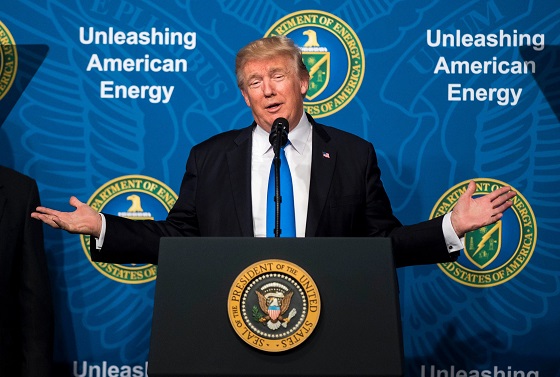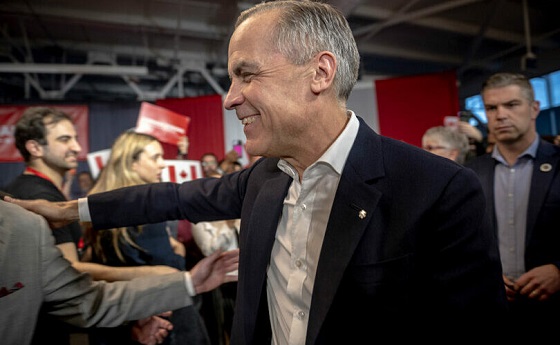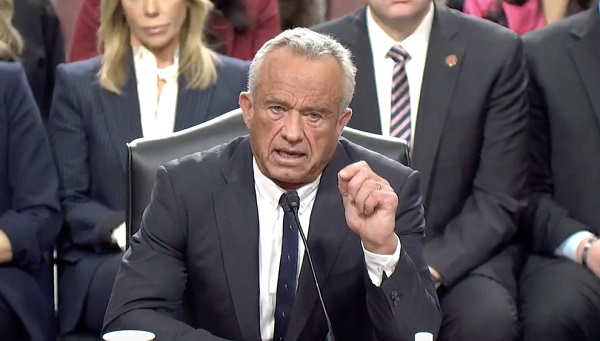Energy
Trump’s Administration Can Supercharge America’s Energy Comeback Even Further


From the Daily Caller News Foundation
By Curtis Schube
One of the first executive orders President Trump issued was “Unleashing American Energy.”
It begins an effort to undo the harm caused by the Biden administration’s unprecedented assault on the American energy sector. It overturns President Biden’s own destructive executive orders, including those canceling oil leases and prioritizing environmental regulations over the good of the economy and producing reliable energy.
It also orders that unduly burdensome energy regulations be rescinded. Trump’s EO forthrightly states that its goal is to encourage energy production “to meet the needs of our citizens and solidify the United States as a global energy leader.”
This executive order takes the nation in a whole new direction. It orders the agencies to audit their policies to weed out burdensome regulations that impact energy development. It terminates the infamous Green New Deal. It prioritizes employment and economic impacts in energy policy. It also revokes a Jimmy Carter Executive Order to reduce the burden on environmental studies that notoriously hold up energy projects.
One reform that met less pomp and circumstance, but is not lacking in impact, is permitting reform. President Trump’s Order instructs agencies to “eliminate all delays within their respective permitting processes including … the use of general permitting and permit by rule.”
This type of permitting reform should impact all American lives for the better. We all know how difficult permits can be to obtain, even if on a smaller scale than energy. When making an addition to a house, for example, one must submit it to government and pray that everything is correct.
Then, the waiting game begins as the government reviews the application, requires possible alterations at the its whim, then, eventually at some point, the project can move forward. It can be expensive and time consuming, and sometimes may deter people from even trying.
The same applies on a larger scale. Permits for major projects, like an oil well, can take years, even a decade or longer, to jump through all of the hoops. And, as the federal government is the gatekeeper to many different varieties of activities that require a permit, whoever is in charge of the executive branch can cripple a project.
Permits by rule and general permits simplify the process drastically and ease the burden on both the applicant and the government. They are simple and predictable. For both types of permits, the government will first pre-determine the required criteria for someone to meet before the permitted conduct can commence. The government will promulgate the standards for all to see and know.
The applicant, knowing exactly what is required to perform the permitted conduct, can get a project moving quickly. For a general permit, no contact with the government is even needed. A permittee can begin a project so long as it satisfies the pre-set standards.
For a permit by rule, the applicant simply has to certify to the government, in writing, that all the criteria have been met. In response, the government can only check to see if the correct certifications are made and then either approve it or return the certifications with an explanation of which ones are not met. This is done in a short period of time, such as 30 days.
In both cases, the government has no discretion on a case-by-case basis. Instead of focusing its efforts as a gatekeeper for permits, the government will only focus on permittees who have not met the criteria, but after the permittee has begun its project. The government’s role is focused on enforcement actions.
Both sides benefit from this system. For those who behave correctly, the permitting process does not hold up projects. For the government, the resource drain for overseeing permitting is drastically reduced. The government only has to focus its attention on the minority of parties.
This system also has a built-in deterrent. If a permittee were to begin a project, only to have the government shut the project down at a later time through an enforcement action, the permittee would lose a significant investment.
The true benefit is to the American people. If energy companies can have a quick and expedited form of permitting, then the supply of energy can expand quicker. This makes the cost of energy, and all products, cheaper. In the wake of natural disasters, rebuilding can happen quicker. Infrastructure can be put in place faster. The benefits go on and on.
Permitting reform, such as that referenced in President Trump’s Executive Order, is a fantastic first step toward a more efficient government. His agencies should take full advantage and convert as many permits as possible to a permit by rule or general permit as soon as possible.
Curtis Schube is the Executive Director for Council to Modernize Governance, a think tank committed to making the administration of government more efficient, representative, and restrained. He is formerly a constitutional and administrative law attorney.
2025 Federal Election
When it comes to pipelines, Carney’s words flow both ways

 Dan McTeague
Dan McTeague
Well, you’ve got to hand it to Mark Carney. Though he’s only just entered politics — after years of flirting with the idea, while serving on Team Trudeau behind-the-scenes — and despite the fact that he hasn’t been elected to anything yet, he’s become well versed in the ancient political art of speaking out of both sides of his mouth. Like many men seeking high office before him, Carney is happy to say to whoever happens to be in front of him whatever he thinks they want to hear, even if it contradicts what he said to someone else the day before.
Of course, that isn’t so easy to pull off these days. Nowadays pretty much everything a politician says in public is going to pop up on the internet within hours. Which is why it’s been so easy to keep tabs on Carney’s policy flip-flopping.
For just the latest example, last week in Calgary Carney opened his pitch to a sceptical province by saying, “You don’t need to tell me what Alberta is like. I’m from Alberta!” He proclaimed that “Canada has a tremendous opportunity to be the world’s leading energy superpower,” and that “we must invest in our natural strengths and ensure our economic sovereignty!” He promised to “identify projects of national interest,” and fast-track them, while acknowledging that “any major energy project that comes from this great province is going to pass the boundaries of other provinces.”
The implication was that voting for a Carney-led Liberal government would mean a major course correction from the ‘Lost Decade” of Liberal governance, that oil and gas from Alberta should be harnessed to power Canada to prosperity, with pipeline projects (maybe a revived Energy East) spanning every province (presumably over the objections of the government of Quebec, these being projects in the “national interest” and all), and the construction of terminals — of the type for which Trudeau previously said there was no “business case” — enabling us to get Canadian Natural Gas onto tankers bound for Europe and Asia. What else could he have meant by ‘global energy superpower,’ ‘self-sufficiency,’ and the promise to invest in Alberta’s energy infrastructure?
But then Carney found himself being interviewed in Montreal, and his approach was quite different. After his interviewer poked some fun at Carney’s tendency to crib policy proposals from the Conservatives — “do you find Mr. Poilievre has good ideas?” — Carney was asked about his “energy superpower” comments, and he hedged, saying that Canada should work to develop its own resources “if there is social acceptability.” Asked about pipelines specifically, Carney said “We must choose a few projects, a few big projects. Not necessarily pipelines, but maybe pipelines, we’ll see.”
Now, if you think that all of this sounds strangely familiar, you’re not crazy. Carney has been doing this dance since he first stepped out from behind the curtain, saying one thing out west and another back east.
Speaking in B.C. in February he aped a Donald Trump line by saying he wanted Canada to “build, baby, build,” and promised to use “the emergency powers of the federal government to accelerate the major projects that we need in order to build this economy and take on the Americans,” clarifying to CBC that those major projects included pipelines. But then, in a French-language interview, he was asked if he planned to force Quebec to accept a pipeline, and he answered, “I would never impose [a pipeline] on Quebec.”
These examples should be enough to demonstrate that Mark Carney is a Con Man. But who, exactly, is his mark? Is he telling the truth in Quebec, where he’s looking to syphon off support from the Bloc Québécois? Or is he telling the truth in Alberta, where he’d love to snatch a few more urban ridings from the Conservatives?
The answer is that, actually, we’re all his mark. Carney doesn’t really care about Quebec’s sovereignty, or any contentious constitutional question like that. And he certainly has no desire to build pipelines and LNG terminals in order to turn Canada into a global energy superpower. A glance at his long career, as both a public and private sector Net-Zero activist, pressuring both individual corporations and national governments to adopt his environmentalist ideology, will tell you as much.
Once you accept that, you start to notice Carney’s sleight-of-hand on questions of energy and affordability. He’s taking credit for “Axing the Carbon Tax,” when in reality he merely zeroed out part of it, while doubling down on the other half. He’s set it up so that he can bring the Consumer Carbon Tax back whenever he likes, without a vote. Meanwhile, our economy will be slowly strangled by the Industrial Carbon Tax, and our everyday lives will get more expensive as businesses pass the cost down to us.
He remains committed to Bill C-69, the “No More Pipelines Act,” which the Supreme Court said overstepped the federal government’s constitutional authority, which itself shows that his mealy-mouthed talking points on pipelines and energy infrastructure don’t amount to a real commitment to anything. And he still supports the Trudeau government’s emissions caps, which target our Natural Resource Sector, the beating heart of Canada’s economy.
And of course he does, because long ago Mark Carney pledged allegiance to the destructive Net-Zero ideology, and it is that, more than anything else, which is the groundwork for how he will actually govern.
So, whatever you do, don’t buy the con. Mark Carney has spent an entire career, before the start of this campaign, telling us exactly who he is. Don’t let him pull the wool over your eyes now.
Dan McTeague is President of Canadians for Affordable Energy.
Support Dan’s Work to Keep Canadian Energy Affordable!
Canadians for Affordable Energy is run by Dan McTeague, former MP and founder of Gas Wizard. We stand up and fight for more affordable energy.
2025 Federal Election
Mark Carney Wants You to Forget He Clearly Opposes the Development and Export of Canada’s Natural Resources

From Energy Now
At COP26, Mark Carney also said that he thinks “we have both far far too many fossil fuels in the world” and “as much as half of oil reserves, proven oil reserves need to stay in the ground” climate goals.
Mark Carney claims that he supports Canada’s oil and gas industry and wants to see Canada export more of our natural resources. But Carney is yet again lying.
If Carney was sincere, he would immediately commit to the full repeal of the Liberals’ C-69, the ‘No More Pipelines’ Act, C-48, the West Coast Tanker Ban, and the production cap. Instead he doubled down on capping Canadian energy production.
But it’s not just that, Mark Carney has a clear history of opposing Canadian energy and infrastructure projects in favour of his radical anti-energy ideology and his goal of shutting down Canadian energy production.
However, while deliberately fighting against Canadian energy, this high flying hypocrite was having his company, Brookfield Asset Management, invest in some of the largest global pipeline projects in Brazil and the United Arab Emirates.
When asked by Conservative Party Leader Pierre Poilievre at an Industry Committee meeting, if he supported Justin Trudeau’s decision to veto the Northern Gateway pipeline, Mark Carney said “given both environmental and commercial reasons … I think it’s the right decision.”
Then, just six months later at COP26, Mark Carney also said that he thinks “we have both far far too many fossil fuels in the world” and “as much as half of oil reserves, proven oil reserves need to stay in the ground” climate goals.
If this wasn’t enough Mark Carney has now teamed up with Trudeau’s radical anti-energy ministers to finish off Canada’s energy sector, a goal that he has outlined while attending a World Economic Forum event in Davos.
Starting with the radical, self-proclaimed socialist, Steven Guilbeault, who’s history of anti-energy and infrastructure policies is all too familiar to Canadians.
Mark Carney has enabled Steven Guilbeault to do even more damage by promoting him to his Quebec Lieutenant, giving him three new ministerial responsibilities so he can continue his climate crusade against Canadian energy and infrastructure projects.
Canadians remember when Guilbeault said that “I disagree with the [Trans Mountain] pipeline” and that “Canada shouldn’t be investing in new infrastructure for fossil fuels.”
They also remember when he proudly proclaimed that “Our government has made the decision to stop investing in new road infrastructure.” All from a minister who shamed Canadians for owning cars.
Then there is the pipeline hating Jonathan Wilkinson, who Carney appointed as Canada’s Minister of Energy and Natural Resources. Recently, Wilkinson wrote a scathing letter to Canada’s energy leaders for their opposition to the Carney-Trudeau Liberals production cap on Canadian oil and gas.
Despite Canadian industries being subject to unjustified tariffs from the United States, Jonathan Wilkinson recently told reporters that “Everybody’s sort of running around saying, ‘Oh my God, we need a new pipeline, we need a new pipeline.’ The question is, well, why do we need a new pipeline?”
Finally, there is Carney’s new Minister of Environment and Climate Change Terry Duguid. Duguid has doubled down on Mark Carney’s climate radicalism by stating that “a Mark Carney government will maintain the cap on emissions from the production of oil and gas”.
From 2015 to 2021 Carney-Trudeau environmental and anti-industry policies have cancelled over $176 billion in Canadian energy projects, with many more being cancelled afterwards. That means $176 billion worth of jobs and powerful paycheques have been blocked from Canadians so Mark Carney and his Ministers can impose their radical net zero ideology.
-

 2025 Federal Election2 days ago
2025 Federal Election2 days agoMark Carney Wants You to Forget He Clearly Opposes the Development and Export of Canada’s Natural Resources
-

 International2 days ago
International2 days agoPope Francis’ body on display at the Vatican until Friday
-

 Business2 days ago
Business2 days agoHudson’s Bay Bid Raises Red Flags Over Foreign Influence
-

 2025 Federal Election2 days ago
2025 Federal Election2 days agoCanada’s pipeline builders ready to get to work
-

 2025 Federal Election1 day ago
2025 Federal Election1 day agoFormer WEF insider accuses Mark Carney of using fear tactics to usher globalism into Canada
-

 2025 Federal Election13 hours ago
2025 Federal Election13 hours agoCarney’s Hidden Climate Finance Agenda
-

 COVID-191 day ago
COVID-191 day agoRFK Jr. Launches Long-Awaited Offensive Against COVID-19 mRNA Shots
-

 2025 Federal Election2 days ago
2025 Federal Election2 days agoCanada’s press tries to turn the gender debate into a non-issue, pretend it’s not happening



